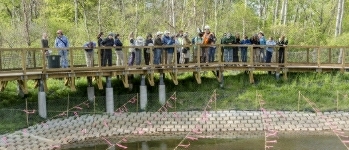James Hansen at MIT
SUN APR 20, 2014 AT 12:44 PM PDT
by gmoke
James Hansen visited MIT on April 15 and April 16 and gave two public talks. One was for Fossil Free MIT (http://www.fossilfreemit.org), a new student group concerned with divestment, on the politics of climate change, "Combatting the Climate Crisis: the Path from Science to Action," and the other was for the climate science community on "Ice Sheet Melt, Sea Level and Storms," the subject of a paper he is now working on.
The good news is that, according to Hansen, we do not have to worry about catastrophic methane releases from the tundra or ocean clathrates as the paleoclimate record shows there were no such releases in higher temperature periods.
The bad news is that, according to a paper Hansen is now working on, we do have to worry about the effects of ice sheet melt on ocean currents and thermoclines as well as the possibility of dramatic wind intensity increases in storms. Again, based upon the paleoclimate and geologic record.
Hansen would have preferred to title the political talk "Challenge for young people: how to make the unfolding climate crisis an opportunity" as he believes that confronting the climate issue can be beneficial, that the prospect is not all doom and gloom. However, he also said, "We have almost as much warming in the pipeline as has already occurred" (0.8º C which means at least 1.6º C cumulative even if we stop now).
Climate impacts we are already seeing include ice sheet disintegration, sea level rise, species extinction, weather extremes. Comparing the present climate to the paleoclimate record can help us predict some of the impacts. During the Eemian, the interglacial period 130,000 years ago, temperature was 2º C warmer than now and sea level was 5-9 meters higher; during the Pliocene, 5.332 million to 2.588 million years ago, the temperature was 3-4º C higher and sea level was up to 66 feet (20 meters) higher than today.
As long-time gardeners know, climate zones have been consistently shifting Northwards. Previously, this shift is now happening at the rate of a few kilometer per year, making it very difficult for many species to react. Hansen used the Monarch butterfly as his example of species extinction pressure, talking about his personal experience over the years with Monarchs on his small PA farmstead. The pressures on Monarch butterflies are not only climate but the elimination of one of their primary food sources, milkweed, although climate change is certainly one of the reasons for the diminishment of their habitat, both here in the US and Canada as well as Mexico.
One of the steps people can take to reverse the collapse of the Monarch butterfly population is to plant milkweeds seed and remove black swallow wort, an invasive plant Monarchs can mistake for milkweed which is poisonous to them (http://www.cctvcambridge.org/…). More information on Monarch preservation is available through these resources:
http://monarchwatch.org
http://www.monarchbutterflyfund.org
http://www.monarch-butterfly.com/…
http://www.flightofthebutterflies.com/…
https://www.livemonarch.com/…
He also mentioned the coral reefs which are habitat for a million or more species and vanishing at the rate of 1% per yer through ocean acidification and other mechanisms. In addition, precipitation is happening in more violent events, more snow and rain per hour, a reality that the weather data supports conclusively.
"We can't burn all our fossil fuels... The limit should be 500 gigatons of carbon and we've already burned 390 gigatons." (I'm not sure that I got these figures correctly in my note taking.)
Hansen believes that 2ºC is no longer a reasonable target, especially since there is such a strong correlation between sea level rise and temperature. He calls for a quick coal phase-out, no unconventional fossil fuels like shale oil or fracking, and a price on carbon. His preference is not cap and trade but fee and dividend which covers all fossil fuels and distributes all the dividends directly to the people, an equal amount to all legal residents without one dime going to government. The only US national legislation that is even close to that is the Boxer/Sanders Climate Protection Act of 2013 which Hansen does not completely support as it retains 40% of the carbon fees for the government and does not pass through 100% of the fees to the people. We need to reduce fossil fuel consumption by 30% by 2024 or 2025. If US and China decide to adopt fee and dividend, it would change everything. (The US is not likely to pass any climate legislation in the near future and China has embarked on a pilot program of municipal cap and trade over the last year or so.) More information is available from http://www.citizensclimatelobby.org, which supports fee and dividend.
"Basically, what we have to do is decarbonize our energy." Sweden is closest to this decarbonization process and they made the transition in about a decade.
Hansen supports new nuclear technologies, fast reactors and thorium reactors with safe shutdown and automatic or no cooling. He believes that renewables are not enough. That, contra Amory Lovins, efficiency is not enough. I was happy to see him display one of my favorite graphs from Lovins' original Foreign Affairs artvicle back in 1974. This graph compares the hard energy and soft energy paths with projections of US energy usage going out to the mid-21st century. According to the estimates of the usual sources, International Energy Agency, US Energy Information Agency, and others, we should be using 200-300 quadrillion btu's of energy per year about now. However, in reality, the US has peaked at about 100 quads and been at or below that annual energy budget for about 20 years now while still raising GDP and growing the economy, (despite the best efforts of the banksters).
Hansen believes that climate change is a matter of "intergenerational injustice," that there is a legal case to be made for children to sue for the harm they will have to endure if their elders continue on the path we've presently laid out. There is, in fact, a Federal lawsuit on this issue to be heard in the DC district on May 2. Further information may be available from http://www.ourchildrenstrust.org.
During the Q and A, Hansen had to deal with a representative of the Revolutionary Communist Party who told us that capitalism is the problem (and Bob Avakian has all the answers) and someone very worried about chem-trails in the sky.
The next day, April 16, Hansen spoke on "Ice Sheet Melt, Sea Level and Storms" to MIT's climate scientists. In contrast to his political speech which was confident and self-assured, his scientific speech was diffident and halting as he hadn't completed the paper or finalized his work. He told the audience that one of the reasons why he accepted the invitation to speak was as a spur to finish his paper. I suspect that his political work has interfered with his scientific pursuits and hope that he gets back to the science soon.
He told us that anthropogenic carbon forcing dwarfs anything else affecting climate, that there is a possibility of rapid ice melt, that the paleoclimate record shows rapid changes in ocean currents at temperatures like those today, that such changes can happen again. Such cooling of the North Atlantic can increase wind speeds to dangerous levels during storms. If Greenland gets warm enough, all bets are off. Greenland ice melt may be much more dangerous than we currently consider. The loss of one meter of ice sheet melt begins to set some of these effects into motion.
Hansen is extremely approachable and was willing to talk to almost anybody. He seems to be a gentle man and a gentleman and certainly is a committed and knowledgeable scientist concerned with the future of his children and grandchildren and all the children of the world.
ORIGINALLY POSTED TO GMOKE ON SUN APR 20, 2014 AT 12:44 PM PDT.
ALSO REPUBLISHED BY COMMUNITY SPOTLIGHT.
Preserved by FAR, acessed 2014-04-26 URL: (http://www.dailykos.com/story/2014/04/20/1293369/-James-Hansen-at-MIT)
- Home
- Directions
- FAR Wildlife Blog
- Calendar
- News
- Donate Now
- Get Social!
- Storm Water Wetlands
- Plants and Restoration
- Photos
- Videos
- About & Projects
- Master Plan for Alewife
- Archive
- Newsletters
- Contact
 Presentation Spotlighting Alewife Reservation
Presentation Spotlighting Alewife Reservation
 Follow us on Twitter
Follow us on Twitter
 Like us on Facebook
Like us on Facebook
 Follow us on Instagram
Follow us on Instagram
Forward our web address to a friend!
- An Urban Gem - Alewife Reservation Nature Preserve
- Envisioning The Silver Maple Forest
- History and Policies of Cambridge, Belmont, and DEP
- Storm Water Wetlands
- Friends of Alewife Reservation brochure
(front, back) - Technical Analysis of Upper Alewife Basin
- Watershed: An Excursion in Four Parts
- The River Is A Restless Spirit: Life in the floodplain forest
-
Assessment of Silver Maple forest for DEP Adjudicatory hearings and
Patrick Fairbairn, author of the Assessment - Community Native Garden Flora
The
Alewife Reservation
is a unique natural resource for the communities of Belmont, Arlington and Cambridge
and home to hundreds of species, including hawks, coyotes beavers, snapping turtles, wild turkeys and muskrats,
the reservation is a unique natural resource for the community.
Historical information (Powerpoint)
Friends of Alewife Reservation works to protect and restore this wild area and the surrounding area for the water quality, native plants, animals and over 90 bird species with paths for walking, running and biking, recreation, and for classroom education and research. We regularly steward and preserve the Reservation area for wildlife and for the enjoyment of present and future generations.

(video)
By-Laws
About Friends of Alewife Reservation
Statement of Purpose
Citizen Forester newsletter archive
The Birds of the Cambridge Region of Massachusetts

by William Brewster 1906
Nuttal Ornithological Society
Biodiversity Study of Alewife Reservation Area: Species, Habitat, Ecosystems

Inventories by David Brown, wildlife assessor (2003, 2004.) Published by and available from FAR for $10. Write or call for your copy. (sample)
Updated Dave Brown Inventories (2008, 2010)
Inventories of Alewife Reservation Wetland Plants by Walter Kittredge, Botanist (2013)

